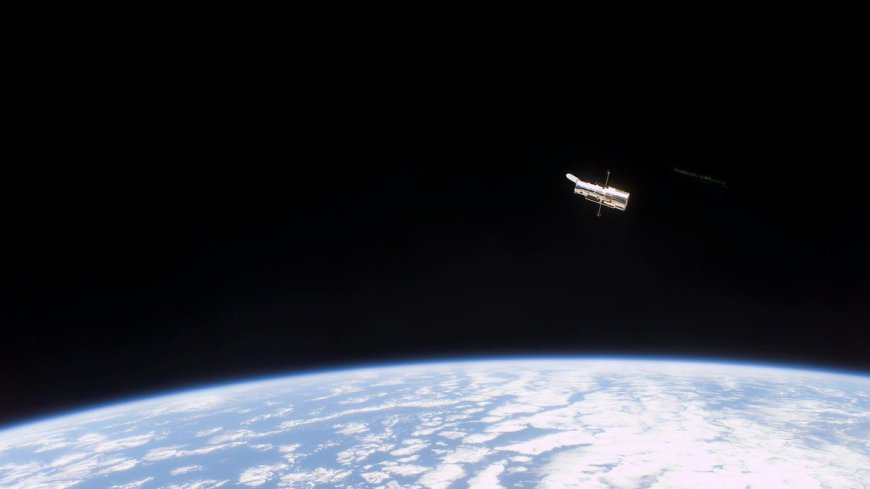Hubble’s 35-year journey is a blueprint to understand the cosmos

Asarkari - Sarkari News, Jobs & Updates
Hubble’s 35-year journey is a blueprint to understand the cosmos
By Priya Sharma
kam sabdo me kahein to, the Hubble Space Telescope, nearing its 35th anniversary, has overcome challenges to revolutionize astronomy, providing stunning images and crucial data on the universe's expansion, dark energy, and distant galaxies, serving as a model for cosmic exploration.
Introduction: An Eye Above the World
Launched into low Earth orbit on April 24, 1990, aboard the Space Shuttle Discovery, the Hubble Space Telescope (HST) was more than just a scientific instrument; it was a promise. A joint project between NASA and the European Space Agency (ESA), Hubble aimed to provide an unprecedented, crystal-clear view of the universe, free from the distorting effects of Earth's atmosphere. As it approaches its 35th year of operation in 2025, Hubble's journey hasn't just fulfilled that promise – it has fundamentally reshaped our understanding of the cosmos and provided a working blueprint for cosmic exploration.
Overcoming Adversity: A Telescope Reborn
Hubble's early days were fraught with difficulty. Soon after deployment, scientists discovered a flaw in its primary mirror – a tiny spherical aberration, just 1/50th the thickness of a human hair, that resulted in blurry images. It was a major setback, casting doubt on the multi-billion dollar project. However, the ingenuity of engineers and astronauts shone through. The first Servicing Mission (SM1) in 1993 saw astronauts install corrective optics (COSTAR) and replace the original Wide Field Planetary Camera with WFPC2, which had built-in correction. This mission was a stunning success, restoring Hubble's vision and marking the beginning of its remarkable scientific career. Four subsequent servicing missions further upgraded its instruments, extending its lifespan and capabilities far beyond original expectations. These missions themselves became blueprints for complex in-orbit repairs and upgrades.
A Revolution in Astronomy: Peering into the Deep
With its vision corrected and instruments enhanced, Hubble began its torrent of discoveries. Its observations provided crucial data for calculating the Hubble Constant – the rate at which the universe is expanding – with greater precision than ever before. By observing distant supernovae, it provided key evidence for the accelerating expansion of the universe, driven by a mysterious force now called dark energy. This discovery earned the 2011 Nobel Prize in Physics for the lead researchers.
Hubble’s deep field observations, like the iconic Hubble Ultra Deep Field, captured images of thousands of galaxies, some dating back to within a few hundred million years of the Big Bang, allowing astronomers to study galactic evolution over cosmic time. It provided the first visual proof of supermassive black holes residing at the centers of most galaxies and gave us breathtaking images of nebulae, star birth, and planetary death throes, like the famous Pillars of Creation in the Eagle Nebula. Hubble also played a vital role in studying exoplanets, even analyzing the composition of their atmospheres. For more updates on space exploration and scientific breakthroughs, visit https://asarkari.com.
The Enduring Legacy: A Foundation for the Future
While newer telescopes like the James Webb Space Telescope (JWST) now probe even deeper into the infrared universe, Hubble remains a unique and powerful observatory, particularly strong in visible and ultraviolet light observations. The two telescopes often work synergistically, providing complementary data that offers a more complete picture of celestial objects. Hubble's vast archive of data continues to be a treasure trove for astronomers worldwide, leading to new discoveries years after the observations were made.
Beyond its scientific output, Hubble's greatest legacy might be its cultural impact. Its stunning images have captured the public imagination, bringing the wonders of the universe into homes and classrooms globally, inspiring countless individuals. The entire operational model – from launch and servicing to data dissemination and international collaboration – serves as an invaluable blueprint for current and future space missions.
Conclusion: A Continuing Voyage
Hubble's nearly 35-year journey is a testament to human ingenuity, perseverance, and our insatiable curiosity about the universe. It overcame initial failure to become arguably the most productive scientific instrument ever built. Its discoveries have rewritten textbooks, and its images have become cultural icons. As it continues its observations, the Hubble Space Telescope stands not just as a window to the cosmos, but as a foundational blueprint upon which future explorations are built, constantly reminding us of the vast, beautiful, and mysterious universe we inhabit.
Team Asarkari
Keywords
Hubble Space Telescope, space exploration, astronomy discoveries, deep space images, universe expansion, dark energy, exoplanets, NASA, ESA, space telescope legacy, Hubble 35th anniversary, Pillars of Creation, Hubble Ultra Deep Field, servicing missions, space scienceWhat's Your Reaction?
 Like
0
Like
0
 Dislike
0
Dislike
0
 Love
0
Love
0
 Funny
0
Funny
0
 Angry
0
Angry
0
 Sad
0
Sad
0
 Wow
0
Wow
0








































